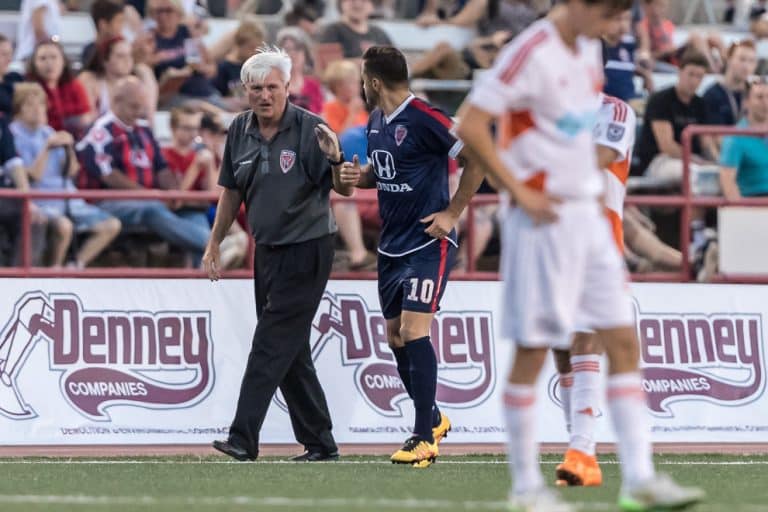Twickenham: The Home of England Rugby by Phil McGowan is an incredible rugby title. Yes, it is the history of a stadium, but it is much more than that. It’s a history of rugby in England and all of the key figures and events over the years. You find out quickly that Twickenham is a lot of things to a lot of people: a national sporting treasure, icon of world rugby, and a shrine of England.
But one thing is for certain: Twickenham rescued English rugby in a number of ways. The reader will certainly appreciate this idea when they are done with the book. McGowan starts off with a history of the stadium and ends up with the definitive text on England rugby.

It starts out well with a brief but poignant foreword from England head coach Stuart Lancaster. It moves into a chronological account of English rugby from the perspective of Twickenham. We were quite pleased with the brilliant photos found throughout the book; they added so much depth to the text.
The story of Twickenham is the story of William Cail, a man responsible for delivering a national rugby stadium. His project management skills and financial acumen saw the stadium through completion. The early nickname for the grounds was “The Cabbage Patch”so you can imagine that getting people to the new stadium was a bit of a challenge. Putting “butts in the seats” would help the Rugby Football Union (RFU) get back in the black when it came to the financial hole they had to created with the expensive stadium project. The stadium wouldn’t be ready until the fall of 1908.
Harlequins was the first “tenant” thanks to a groundshare agreement with the RFU. Twickenham was very good to Harlequins as they won 448 games out of 760 from 1909 through 1990.
January 15, 1910 was a big day for Twickenham as 18,000 spectators saw England defeat Wales for the first time in over a decade. Even the future King George V, who was a regular until 1936, was in attendance. 20,000 would later see England draw with Ireland. Away wins against both France and Scotland would give unbeaten England their first Championship since 1892. It would actually be another 16 years before any visiting Five Nations experienced victory at Twickenham. One of the players said that the stadium brought them good luck thanks to a “good fairy.”
In just five years, Twickenham transformed England rugby from being incapable of winning to being the dominant program in the Northern Hemisphere. England won four Championships in five years, including two Grand Slams.
World War I ended progress for England rugby and the country as a whole. Horses would be turned out at Twickenham to graze, preparing them for duty on the front lines. The people that played at Twickenham paid a heavy toll. Twelve men that represented England and Scotland in the 1914 Calcutta Cup died in the First World War. After the war ended, the King’s Cup would emerge as a key competition in 1919, featuring six sides from across the British Empire.
A new North Stand came about in 1924 and the RFU was rewarded with a record gate of 60,000. By 1936 expansion was completed at the South Terrace and 73,ooo came out for a match against New Zealand. The stadium improvements were just one way that Twickenham was a trendsetter for sport.
In 1927, the BBC arrived at Twickenham to broadcast matches. Just 11 years later the 52nd Calcutta Cup was broadcast live on TV.
But great progress was brought to a halt by World War II as Twickenham became a makeshift civil defense depot. It was damaged repeatedly during the war. In 1944 a German bomb exploded nearby, caused serious damage to the West Stand. Constant air raids and relentless anti-aircraft fire caused damage to three other stands. Recovery was slow after the war and France would actually dominate in the 60s and 70s.
Harold Clark became a key figure, perhaps as important as Cail, in 1964. He led the transformation of a stadium that never recovered from WWII. Events like the County Championship, the RFU Cup, the Premiership, the European Cup, and the School Final all called Twickenham home.
But the tournament that permanently altered the course of world rugby was the 1991 Rugby World Cup. Satellite television brought about a global audience of 1.5-2 billion. Simply put, the brand of rugby went global overnight. It was a massive commercial success, putting 20 million pounds into the IRB’s coffers.
Architect Terry Ward was another key figure, helping turn Twickenham into a 21st Century stadium. Alf Wright would also contribute in a big way, preserving RFU history, collecting artifacts that dated back to 1871.
The 1999 Rugby World Cup in Wales saw Twickenham host England’s pool matches and both semifinals. The stadium would see the most spectacular comeback in Rugby World Cup as France defeated Jonah Lomu’s New Zealand to push the French to the final.
England would win just four years later, defeating Australia for the William Webb Ellis Cup. Unfortunately the English couldn’t repeat that success in recent events, including the 2015 World Cup that they hosted.
Twickenham continued to grow in size and importance and by 2004 the seating was 82,000. That capacity made Twickenham the largest stadium in the world dedicated solely to rugby. The South Stand would include a health club, a four-star hotel, a theatre, and office space for 205 RFU employees.
The 7s have been popular for a while, but the London 7s attracted a record 110,000 over two days, making the event the most popular on the Twickenham calendar. It’s just another way that Twickenham has made a difference in the world of England rugby.
Phil McGowan did a brilliant job with this one and it shows that Amberley Publishing is also a major force on the rugby side of publishing. They’ve already produced great football titles time after time and this beautiful book is just another part of their impressive portfolio.






